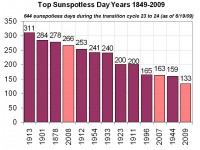NASA, June 17, 2009
The sun is in the pits of a century-class solar minimum, and sunspots have been puzzlingly scarce for more than two years. Now, for the first time, solar physicists might understand why.
At an American Astronomical Society press conference today in Boulder, Colorado, researchers announced that a jet stream deep inside the sun is migrating slower than usual through the star’s interior, giving rise to the current lack of sunspots.
Rachel Howe and Frank Hill of the National Solar Observatory (NSO) in Tucson, Arizona, used a technique called helioseismology to detect and track the jet stream down to depths of 7,000 km below the surface of the sun. The sun generates new jet streams near its poles every 11 years, they explained to a room full of reporters and fellow scientists. The streams migrate slowly from the poles to the equator and when a jet stream reaches the critical latitude of 22 degrees, new-cycle sunspots begin to appear.

Above: A helioseismic map of the solar interior (large image here). Tilted red-yellow bands trace solar jet streams. Black contours denote sunspot activity. When the jet streams reach a critical latitude around 22 degrees, sunspot activity intensifies. [more graphics]
Howe and Hill found that the stream associated with the next solar cycle has moved sluggishly, taking three years to cover a 10 degree range in latitude compared to only two years for the previous solar cycle.
The jet stream is now, finally, reaching the critical latitude, heralding a return of solar activity in the months and years ahead. “It is exciting to see”, says Hill, “that just as this sluggish stream reaches the usual active latitude of 22 degrees, a year late, we finally begin to see new groups of sunspots emerging.”
The current solar minimum has been so long and deep, it prompted some scientists to speculate that the sun might enter a long period with no sunspot activity at all, akin to the Maunder Minimum of the 17th century. This new result dispells those concerns. The sun’s internal magnetic dynamo is still operating, and the sunspot cycle is not “broken.”
“We still don’t understand exactly how jet streams trigger sunspot production,” says Pesnell. “Nor do we fully understand how the jet streams themselves are generated.”
To solve these mysteries, and others, NASA plans to launch the Solar Dynamics Observatory (SDO) later this year. SDO is equipped with sophisticated helioseismology sensors that will allow it to probe the solar interior better than ever before. Read full release here.
Icecap Note: Solar guru Leif Svalgard in a comment on this release on Watts Up With That notes “This press release is just NASA PR-machine hype. We have not ‘solved’ the problem. Even if we assume that the ‘jetstream’ has anything to do with the generation of spots [and I personally think it is the other way around] we have just moved the problem [rather than solving it] because now the question is “why was it slower?” Furthermore the ‘critical 22 degrees’ is not based on anything other than having happened once before.
What we have is a well-orchestrated CYA attempt: our [i.e. NASA-supported] models [predicting a super-cycle] were thwarted by this strange delay of the oscillation, but are basically correct [I think not].”
One other note from Icecap: Phoenix has gone 15 days without 100F, the longest stretch in June since 1913, the only year in the last century with more and sunspotless days and the fourth highest sunspotless days since 1849. This year is likely to reach the top 10 also along with 2007 and 2008. Coincidence?





